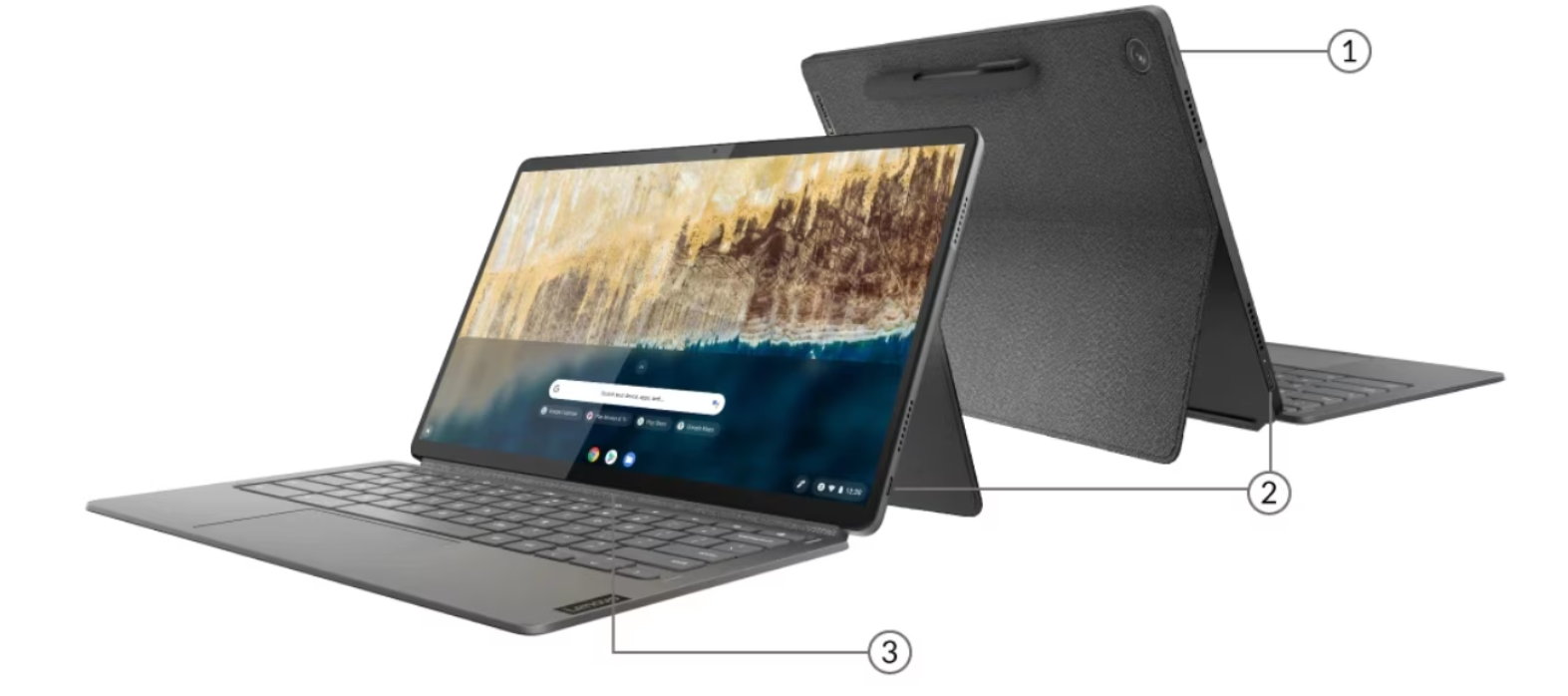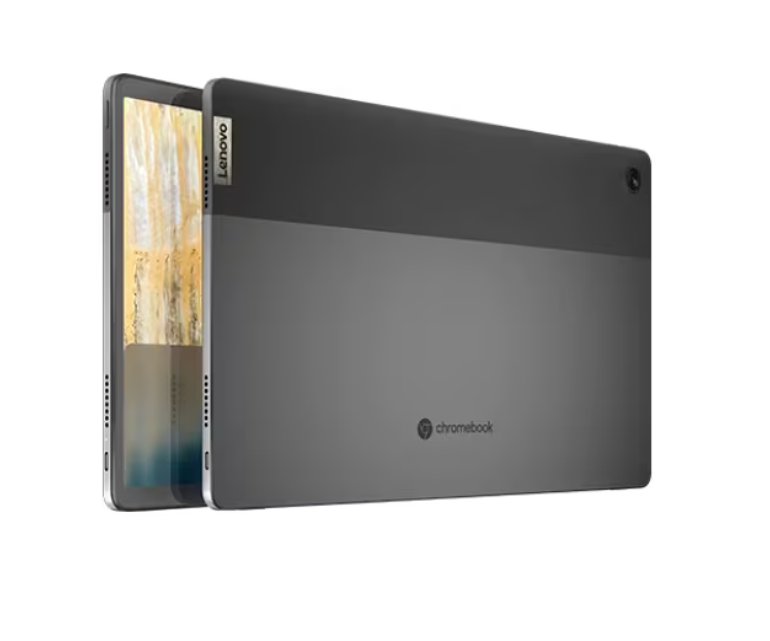Surprises in many aspects when choosing a new tablet, you are likely considering models with either Android or iOS. While there are models with Windows in the market as well, they cater to a specific audience and require additional investment for decent hardware performance. Additionally, the ChromeOS-powered tablet category, which falls between these two worlds, tends to be overlooked. Lenovo IdeaPad Duet 5 Chromebook aims to convince customers that Chromebook tablets are worth considering. Does it succeed?
Packaging of Lenovo IdeaPad Duet 5 Chromebook Inside the slim yet relatively spacious box, you’ll find a rich set of accessories accompanying the tablet, including almost everything you might need. Competitors could learn from Lenovo in this aspect. You can judge for yourself whether the list of contents in the package is exhaustive.
- Lenovo IdeaPad Duet 5 Chromebook tablet
- Back magnetic cover with a stand
- Keyboard with a touchpad, also serving as the front cover
- Touch pen
- 30W power adapter
- USB-C cable
- Basic manuals
Quality Construction and Recognizable Design
Recent Lenovo tablets often feature a design combining two colours and sometimes two different materials on the back. The same applies to the tablet being tested today, the Lenovo IdeaPad Duet 5 Chromebook. It has a back and edges made of two-thirds smooth, dark grey aluminium. The upper third is covered with a lighter rubbery surface. Design perception is subjective, but from my perspective, the tablet is elegant and exudes quality and premium aesthetics at first glance.

The front is dominated by the display, with relatively thin bezels as per current design trends. Although the bezels aren’t symmetrical, being wider on the longer side, this arrangement doesn’t bother me much, as it provides a better grip for holding the tablet. Handling and working purely with the tablet can be a bit complicated, considering that the Lenovo IdeaPad Duet 5 Chromebook features a straight 13″ display. Furthermore, the display has a 16:9 aspect ratio, typical for laptops but not for tablets, which are usually slightly less wide. The overall dimensions of the tablet are 305.86 x 186.74 x 7.23 mm, with a weight of 700 grams.
Practical Back Cover of IdeaPad Duet 5 Chromebook
The dimensions and weight suggest that using the device as a regular tablet might be a bit cumbersome. After all, who would want to hold such a heavy and large “sail” in one hand while working with the other? The Lenovo IdeaPad Duet 5 Chromebook has a different role than classic Android tablets in this regard, as indicated by the included accessories in the basic package—a rear magnetic cover with a flip-out stand and an attachable keyboard.
Simply attaching the rear cover with the stand significantly simplifies working with the tablet. With the stand flipped out, you can place the tablet on a table or even on your lap and operate it more comfortably. Thanks to the approximately 170° opening angle, you have wide options for positioning the device. For instance, while taking notes, you can place it on the table and slightly tilt it towards you for comfortable typing. Furthermore, if you use the included touch pen and place its silicone case where the manufacturer intended, there’s essentially no other choice.

The pen case fits into a cutout on the back cover, preventing you from laying the tablet flat. Placing the tablet on the touch pen protected only by the silicone case (which is not the most convenient to remove) also didn’t provide the best experience. Recalling the testing of the Galaxy Tab S7 and its stylus storage solution, I must admit that Lenovo’s solution isn’t the most elegant. On the other hand, considering the price of Samsung’s tablet and the cost of the keyboard case, which you have to buy separately, I’m actually satisfied with Lenovo’s solution. I wasn’t overly concerned about losing the pen, which I believe is the main point here.
Keyboard and Touchpad
The top of the back cover features a textile surface in grey. The same surface is used on the bottom of the keyboard cover. The cover attaches magnetically to the tablet, and its position is secured by two protrusions. The keyboard and touchpad are connected to the tablet by pins on the bottom edge. Similar to most similar solutions, there’s no fixed hinge between the tablet and the keyboard. The mentioned back cover naturally handles the tablet’s upright position. Due to the lack of this fixed connection, using the tablet in “laptop” mode with it on your lap might feel a bit unusual, as the part with the keyboard tilts when you place your wrists on it. Personally, I got used to it fairly quickly, but I believe some people might have issues with it. Ports options for Chromebook is in the picture below.

Considering the need for minimal thickness and weight, it’s not surprising that the keyboard flexes. However, it’s not a significant issue, and it’s a common characteristic of such designs. In fact, Lenovo’s solution is above average in this regard. The more demanding task is the keyboard mechanics, which have a very low travel distance. However, the relatively stiff keypress compensates for this and provides clear feedback. After a short adjustment period, I was able to type comfortably without a noticeable decrease in typing speed or accuracy. Those who write a lot will be thankful. The keyboard layout itself is also practical, so you won’t need to make any major adjustments after switching from a standard keyboard.
The touchpad size is relatively small, which is typical for similar devices. However, the size doesn’t pose a problem since the use of the touchpad isn’t as frequent as on laptops. It’s worth noting that the touchpad is accurate and responsive, which is the most important thing.
IdeaPad Duet 5 Chromebook Display and Speakers
The display’s size of 13″ might not sound small, but it’s the diagonal size, and when it comes to the width of the screen, the situation isn’t so rosy. As I already mentioned, the display has a 16:9 aspect ratio, which is typical for laptops, but not so much for tablets. The relatively low height of the display in portrait mode might not be an issue for everyone, but if you intend to use the tablet primarily in portrait mode, it’s something you should consider. On the other hand, if you intend to watch videos in landscape mode, you’ll be very satisfied.

The display resolution is 1920 x 1080 pixels, which, in my opinion, is a good choice for this diagonal size. It ensures sufficient display sharpness, and Windows users are well aware that this resolution works well in combination with Windows’ scaling settings. Moreover, there’s no reason to strive for higher resolution, which would also be more demanding on the hardware, without providing any substantial benefit.
The display technology used is IPS, which means it’s characterized by vibrant colors and wide viewing angles. The Lenovo IdeaPad Duet 5 Chromebook doesn’t disappoint in this regard. However, its maximum brightness is 350 nits, which might be a limiting factor if you plan to use the tablet outdoors frequently. Indoors, the brightness is more than sufficient, and the anti-reflective layer works well. However, you should still keep this limitation in mind.
As for the speakers, the Lenovo IdeaPad Duet 5 Chromebook has two of them, with the cutouts located on the left and right edges. The speakers’ positioning suggests that their quality and positioning aren’t a priority. The sound quality is average, but it’s sufficient for system sounds and occasional video calls. Of course, you can also connect external speakers or headphones via Bluetooth or the 3.5mm audio jack.
Performance and Battery Life
The Lenovo IdeaPad Duet 5 Chromebook’s performance is ensured by the MediaTek Helio P60T chip. It’s a relatively efficient chip with integrated graphics, which makes it suitable for most tasks that you’d perform on a ChromeOS device. Browsing, watching videos, office work, and similar tasks run smoothly, and you can also run Android apps without any problems. However, more demanding applications and tasks might push this chip to its limits, resulting in slower performance.
The version of the Lenovo IdeaPad Duet 5 Chromebook being tested has 8GB of LPDDR4X RAM, which provides comfortable multitasking within the limitations of the operating system. It’s worth noting that this is currently the only memory configuration available, and as such, it’s commendable that Lenovo didn’t offer a version with only 4GB of RAM, which is often the case with more affordable devices.
The storage capacity is 128GB, which is a sufficient amount for most users, considering the limitations of the ChromeOS platform and the fact that the device isn’t intended for professional multimedia or gaming use. Still, keep in mind that ChromeOS doesn’t offer as many offline capabilities as Windows or macOS.
The Lenovo IdeaPad Duet 5 Chromebook’s battery life is solid, thanks to the 42Wh battery. The actual battery life will depend on your usage patterns, but in typical use scenarios, you can expect around 8-10 hours of use, which is in line with other ChromeOS devices. This battery life should be sufficient for a full day of work or entertainment on the go.
Final Thoughts
Lenovo IdeaPad Duet 5 Chromebook offers a unique combination of features. Its design stands out, and the tablet’s construction is of high quality, especially considering its price. The included accessories significantly enhance its usability and make it a versatile device for various tasks.
The performance is suitable for typical ChromeOS tasks, but keep in mind that more demanding applications or tasks might lead to slower performance. The display is vibrant and sharp, but the 16:9 aspect ratio might not be ideal for all users, especially those who primarily use tablets in portrait mode.
In conclusion, if you’re looking for a ChromeOS-powered device with tablet functionality and a versatile design, the Lenovo IdeaPad Duet 5 Chromebook is definitely worth considering. It’s a budget-friendly option that offers good value for its price and can be a great tool for productivity and entertainment on the go.”





